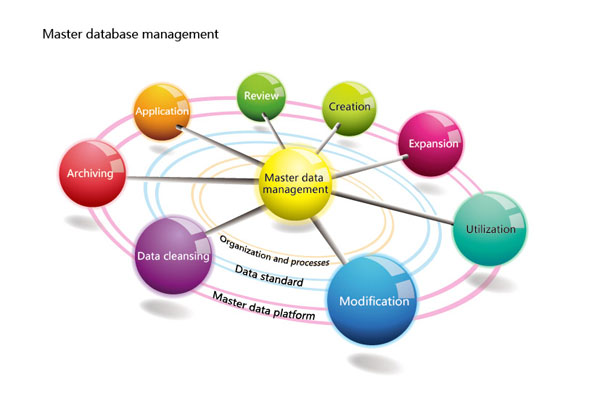Master data refers to the core business objects found in the analysis of the business framework of enterprises, i.e. the existing basic data of all IT systems that concerns the value chain and core business processes. The integrated projects of Galadin MDM are used to describe one or several properties of entities of core corporate business such as customer, supplier, region, product and inventory. They refer to the data that can be repetitively utilized across operational departments of an enterprise and exist in various application systems with diverse structures.
Background
In most enterprises, the information about customers, partners, employees, products, material lists and accounts and other information with high operational value are scattered and fragmented among operational systems and those fragments of information in every operational system are separated from each other. That’s why some enterprises have problems with the master data management. The biggest problem caused by the lack of master data management is a deficiency of integrity and consistency. Some master data are either incomplete or missing and some are copied and updated in multiple systems, causing inconsistency among data.
As data exist in various departments with systems that are based on different frameworks and incompatible to each other, it is hardly possible for enterprises to create a “single” view for the maintenance of master data. In the end, the lack of company-wide integrity and consistency in information and data can lead to the deficiency of standard and coordination in the corporate management, decreasing satisfaction of customers, partners and employees, market behaviors that cannot be coordinated and unified as well as the thereby reduced market share, which will then definitely affect the overall health and development of an enterprise.
Functional Modules
The key of Galadin MDM lies in “management”, i.e. enabling enterprises to effectively manage the data stored in distributed systems. Galadin MDM supports both loose coupling and tight coupling for its integration with all information systems so as to facilitate independent organization and management.

(1) Data Application
Operators can submit data application in Master Data Route System in line with data criteria according to the business requirements in a plain and fast way.
(2) Data Review
The committee for standardization examines and reviews the data validity and unifies standards according to the division of responsibility and labor in the data management process specified in the data criteria.
(3) Date Creation
Applied data can be created in the platform after the validity has been examined and verified.
(4) Data Expansion and Sharing
The updated data can be release in other systems that have subscribed it. The system can share the same set of IT architecture with the data integration system. For example, the system can create a framework for synchronization, activation and subscription of underlying data by adopting SOA or ETL architecture.
(5) Data Utilization
The utilization of master data in operational systems in business transactions like purchase, production and sale is indispensable in Galadin MDM.
(6) Interaction with Data in Master System
The unified and standardized platform can lead to higher efficiency in data modification, cleansing and archiving.
Features
(1) Business-orientation
Business-orientation is the most basic feature of the system. Galadin MDM can perform functions that reflect business needs in an all-around way and make corresponding adjustment along with changes in business and organization so as to enable the system to keep developing and improving within a certain period.
(2) Standardization
Master data management is an important component of the standardization work of enterprises. Establishment of master data criteria is the beginning of the standardization of data and process for enterprises.
(3) Integration
Galadin MDM can provide operational systems in want of master data with core data support and therefore can integrate with most operational systems. The system can effectively integrate the major existing operation and production systems so as to reduce unnecessary waste.
(4) Both decentralized and centralized deployment
Galadin MDM supports model with multiple organizations and structures. It support independent deployment, hierarchical deployment and multi-level deployment during which the exchange and synchronization of data can be customized at will.
(5) Supporting of multiple platforms
Based on the J2EE framework, Galadin MDM can run on various systems like Unix, Linux and Windows and support various databases such as Oracle, DB2, MSSqlSever, etc.
(6) Flexibility
Galadin MDM can flexibly customize master data models without secondary development.
Key Benefits
Galadin MDM can be applied in existing systems and obtain the latest information from these systems, provide advanced technology and processes to dissimilate and analyze all data of an enterprise in an automatic, accurate and timely way and to verify these data.
By setting up and implementing unified, scientific and appropriate data criteria that conform to the business requirements, Galadin MDM can fix the management of the lifecycle of every data object.
Galadin MDM can ensure the integrity and consistency of the master data in all operational links inside an enterprise by implementing the data criteria. By offering a true and high-quality version of data, the system can eliminate the costs of data duplication and improve the data quality.
Galadin MDM can increase the utilization rate of master data and the trust of users in the data quality of enterprises and eventually meet a variety of strategic management targets of enterprises.
Potential Client
Galadin MDM is applicable to a variety of enterprises which need standardizing their various application systems as it can achieve standardization of basic information, integrate data of staff, processes and technology into a set of complete management mechanism, enable all operational entities to be recognized in every system, lay solid foundation for collaboration and data processing and strengthen the safeguard for enterprises in a different way.




